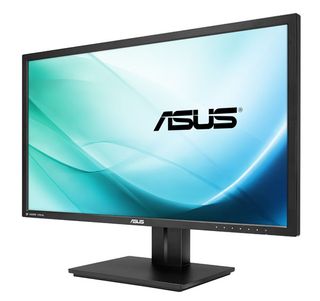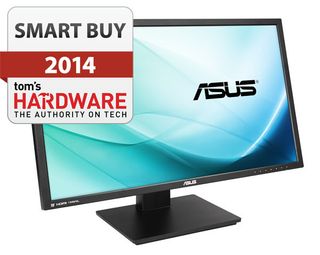Asus PB287Q 28-Inch 4K Monitor Review: Ultra HD For $650
We've seen plenty of buzz about the beauty of gaming at 3840x2160. Up until now, though, that meant spending several grand on a 4K monitor. Asus drives the price down to $650 with its 28-inch PB287Q. But are there sacrifices made in the process?
Asus PB287Q: Ultra HD At An Ultra-Low Price
As with most bleeding-edge technologies, most of the discussion about 4K monitors revolves around price. The first-generation displays hit the market at an eye-watering $3500, and even now are still selling for over $2500.
Thanks to Chi Mei Optronics’ new 28-inch 4K TN panel, we now have the PB287Q available to us at an expected $650, which is about what you'd expect to pay for a mainstream 27-inch QHD display. In the near future, we’ll be reviewing Samsung’s UD590 and Dell’s P2815Q based on the same underlying technology. But for now, Asus owns the day.

Compared to the 32-inch screens we looked at a few months ago, the PB287Q is more refined, especially when it comes to signal handling. Because we're dealing with a single scaler, the dual-HDMI option available on Asus' tiled PQ321Q is no longer available. Rather, if you want to run at 3840x2160 at 60 Hz, you need to use DisplayPort 1.2. I had no problems getting the monitor to work with my Radeon HD 7770 graphics card, which isn't even officially rated to support a resolution that high. If you're using a multi-GPU setup from Nvidia, make sure you have the company's newest driver first.
The monitor's performance is generally good, especially considering Asus' price point. Color, grayscale, and gamma results are on par with other gaming screens and a tad below much more expensive professional displays. Even though contrast is decent compared to the average IPS monitor, we were hoping to see the greater dynamic range offered by the other TN panels we’ve reviewed. Our conclusion for now is that the extra pixel density of Ultra HD seems to lessen the contrast advantage of a TN-based product.
We're glad to see a breakaway from the typical 6-bit with FRC bandwidth limitation of nearly every TN screen out there. The PB287Q uses an 8-bit/FRC panel, which means it can render 1.07 billion colors either by up-sampling an 8-bit signal or passing a 10-bit one. While this feature is of greater interest to photographers and graphics professionals, it's good to know you can have greater bit-depth and greater resolution in one product.
It seems to us that the PB287Q is best suited for gaming. Its most attractive performance attributes surface in the response and input lag tests. Don't expect the PB287Q to match the speeds of a 144 Hz display; however, it competes quite favorably with the 60 Hz BenQ RL2460HT gaming monitor. We also like the inclusion of GamePlus, which we first saw on the VG248QE. Hardware-based aiming reticules are always a handy option, especially when they don’t introduce any processing overhead.
If your gaming rig is well-equipped for high resolutions, but you can't fathom doubling its price (or more) with a first-gen 4K monitor, Asus' new PB287Q has to be looking tantalizing right about now. Really, it represents a new reason to get excited about Ultra HD, which was previously fun to read about, but prohibitively expensive. All of a sudden, testing high-end graphics configurations at 3840x2160 is going to become a lot more important, as the audience previously interested in QHD shifts focus to 4K.
Stay on the Cutting Edge
Join the experts who read Tom's Hardware for the inside track on enthusiast PC tech news — and have for over 25 years. We'll send breaking news and in-depth reviews of CPUs, GPUs, AI, maker hardware and more straight to your inbox.
For its unprecedented value and respectable performance, we’re giving Asus' PB287Q our Tom's Hardware Smart Buy award.

Current page: Asus PB287Q: Ultra HD At An Ultra-Low Price
Prev Page Results: Pixel Response And Input Lag
Christian Eberle is a Contributing Editor for Tom's Hardware US. He's a veteran reviewer of A/V equipment, specializing in monitors. Christian began his obsession with tech when he built his first PC in 1991, a 286 running DOS 3.0 at a blazing 12MHz. In 2006, he undertook training from the Imaging Science Foundation in video calibration and testing and thus started a passion for precise imaging that persists to this day. He is also a professional musician with a degree from the New England Conservatory as a classical bassoonist which he used to good effect as a performer with the West Point Army Band from 1987 to 2013. He enjoys watching movies and listening to high-end audio in his custom-built home theater and can be seen riding trails near his home on a race-ready ICE VTX recumbent trike. Christian enjoys the endless summer in Florida where he lives with his wife and Chihuahua and plays with orchestras around the state.
-
petar - We need to see Article comparing IGZO - PLS - AHVA panels at first place.Reply
- What happened with AHVA panels M270QAN01.0 , M270QAN01.1 , M320QAN01.0 ,M320QAN01.1 from AUO that were planed for 2014 production ? We are in September 2014 now and no one offers them.
It would be good to know who uses which panel, we have ASUS, Iiyama, AOC, DELL, Viewsonic, Samsung selling 4K displays all based on TN... -
JJussi I would like to see compare to AOC U2868PQU 4K display.Reply
There is not so many "cheap" 4K monitors on market and I would like to choose best for myself...
What I know, there is two other products too:
Philips Brilliance 288P
Samsung U28D590D
Most Popular

